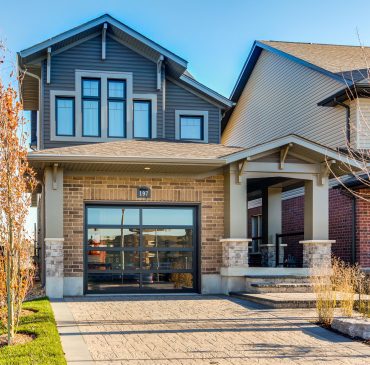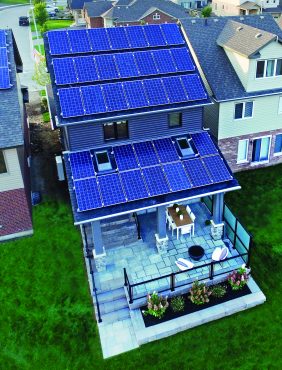
John Bleasby
Reid’s Heritage Homes now 3-time NZE Builder of the Year winner
Canadian ContractorThe EnerQuality Awards honour some of Ontario's best green builders
More than 200 industry peers gathered to share concepts and accolades, as Ontario’s best Green Builders celebrated the EnerQuality Awards Gala (EQ Awards) at the Universal Eventspace in Vaughan, Ontario last month.
“Advancing energy-efficient techniques and tools are huge priorities in the building sector to continue to improve healthy living conditions, fight climate change and minimize unnecessary spending,” said EnerQuality President Corey McBurney. EnerQuality, the number one certifier of energy efficient homes in Canada, is a collaboration of the Ontario Home Builders’ Association (OHBA) and The Canadian Energy Efficiency Alliance (CEEA). EnerQuality manages national certification programs such as EnergyStar and EnerGuide, and the CHBA’s Net Zero Energy program in Ontario, lending a consistency to the ratings that consumers can understand. Approximately 32 per cent of new homes in Ontario are now built to EnerQuality label standards.

Reid’s leadership in NZE-ready construction has resulted in winning NZE Builder of the Year three years in a row
Net Zero Builder of the Year award goes to Reid’s Heritage Homes
One of the major awards each year is the Net Zero Energy (NZE) Builder of the Year Award, initiated three years ago to recognize advances in the industry by builders who advocate advanced practices and bring forward Net Zero communities. For 2017, the winner for the third year running was Reid’s Heritage Homes based in Cambridge, Ontario.
Reid’s has been very progressive in terms of using NZE as a basis of future planning of their projects. Winning the 2017 award is verification of their outlook. “As a builder, we committed a few years ago to building all future single family developments as Net Zero-ready,” Jennifer Weatherston, Director of Innovation & Integration for Reid’s Heritage Homes told Canadian Contractor. “We have two communities right now that are Net Zero-ready, and all our new developments and designs for single family dwellings going forward will follow the same criteria. We’re also now working on our town homes as well.”

Seen from the street, this Reid NZE-ready house looks like any other home on the street
“We need as an industry to keep moving forward “
“It’s a major step forward when production builders start embracing the NZE process, versus the custom builders who have been at the vanguard for so many years,” Ms. Weatherston continued. “The Ontario Building Code will, by 2022, incorporate Net Zero-ready from an envelope perspective. It’s a great advancement, and we need as an industry to keep moving forward.”
Avoiding unintended consequences requires improved education and training
Weatherston supports EnerQuality very important educational component. “EneryQuality has been really good about driving home issues of training evaluators, training builders, and providing the platform for people to advance, while being aware of the unintended consequences.”
Training of construction crews is paramount lest projects fall prey to “unintended consequences” when changes are put in place too quickly or inappropriately. At the same time, training is a factor that Weatherston believes will drive the industry forward, as the number of framers, masons and bricklayers decreases over time due to retirement from the workforce. “There needs to be more training on the tools, and increased understanding the importance of air sealing, proper flashing around windows to prevent water ingress that results in walls taken longer to dry for example,” she notes. “You can mandate it, but if builders start taking shortcuts in order to deliver that product without understanding the envelope, there will be unintended consequences, and then we’re going to have significant failures.”

This Reid home has gone all the way to full Net Zero Energy, with the addition of PV solar arrays installed on rear roof sections
Face it! The future of home building is not current stick construction methods
One direction production building could take in the future is panelization and modularization. “We’re starting to see more components build in a factory environment,” Ms. Weatherston said, observing that skilled workers soon discover the allure of working in a protected environment. “After framing in minus 30 degree weather plus wind-chill, they see the controlled factory environment as more appealing. There are huge efficiency gains to be made in the execution of the home in a factory setting as well, not to mention waste reduction.”
Reid’s fully intends to stay on the leading edge
Reid’s is actively investigating new products, new techniques in what Weatherston called a black-box type process. “We as an industry have to recognize the need to build homes affordably and faster. As a company, we’re going to be testing new technologies to address some of the items that have come up through the Net Zero process, such as mechanical systems that meet the new lower energy loads on the NZ homes without over-loading them.”
Want some fun?
Watch a video that compares current home building methods with modern automobile production!
Got feedback? Make your opinion count by using the comment section below,
or by sending an email to:
JBleasby@canadiancontractor.ca
Follow John on Instagram and on Twitter for notifications about his latest posts

![]()

Leave a Reply